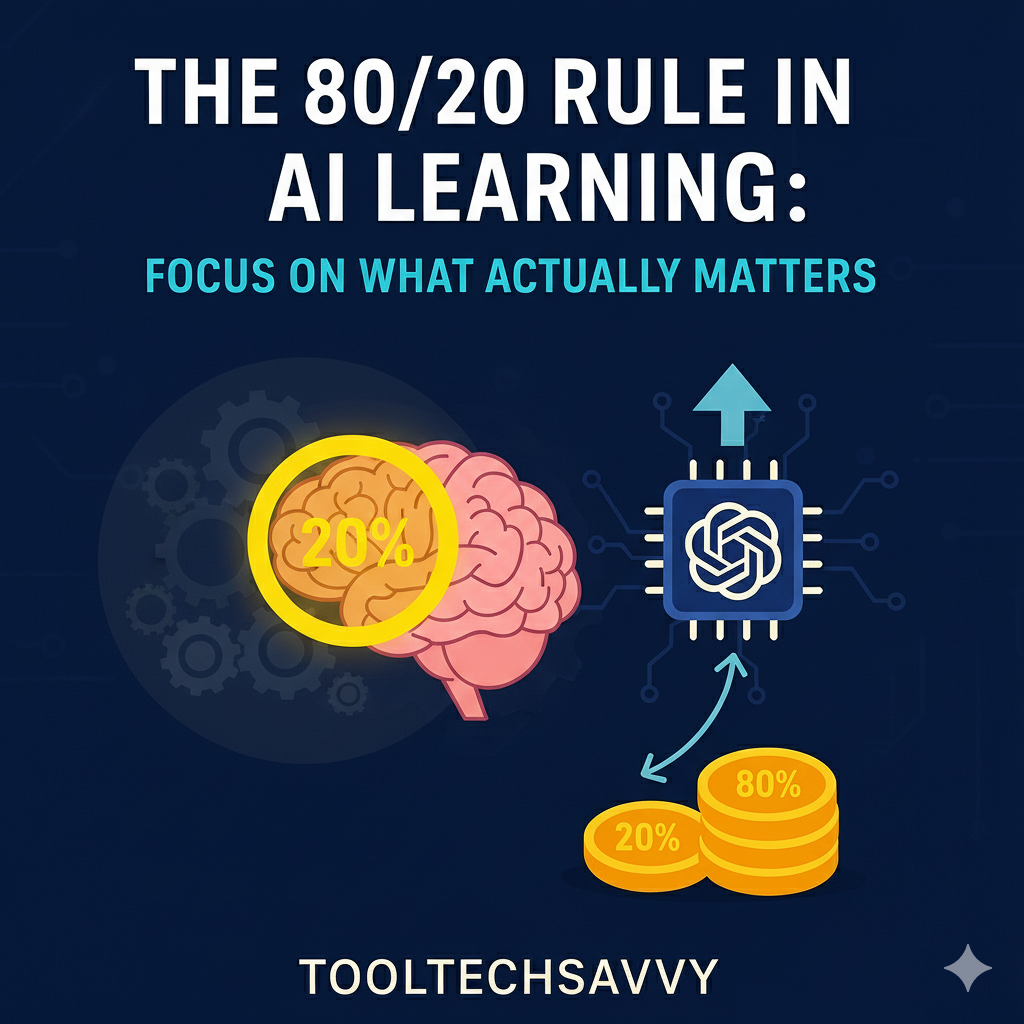If you’ve ever tried learning AI, you’ve probably felt overwhelmed — new tools, endless updates, and thousands of tutorials. The truth? You don’t need to learn everything. The 80/20 rule, also known as the Pareto Principle, teaches that 20% of your efforts create 80% of your results.
Applied to AI learning, this means focusing on the essential few skills and tools that actually drive productivity — and ignoring the rest.
If you’re just starting out, check out ChatGPT for Beginners: 7 Easy Ways to Boost Productivity with AI for simple, high-impact use cases that fit perfectly with this mindset.
The 20% That Matters Most in AI Learning
Let’s face it — you don’t need a PhD to make AI work for you. Most creators, marketers, and solopreneurs benefit most from mastering just a few key areas.
Here’s the vital 20% to focus on in 2025:
- Prompting and Context Framing
Learn how to communicate with AI clearly. A well-crafted prompt can outperform hours of tweaking. Start with 7 Proven ChatGPT Techniques Every Advanced User Should Know to see real examples. - Workflow Automation
You’ll save hours by integrating AI with your tools. For instance, How to Use ChatGPT and Zapier to Automate Your Content Calendar shows how to build automations that run 24/7. - Understanding Model Behavior
You don’t need to dive into machine learning math — just grasp how models interpret your inputs. How to Understand AI Models Without the Jargon breaks this down for beginners. - Experimenting with Free Tools
Explore what works for your workflow before paying for anything. Start with Top 5 Free AI Tools You Can Start Using Today (No Tech Skills Needed).
The 80% You Can Safely Ignore (for Now)
It’s tempting to study everything — neural network architectures, custom fine-tuning, embeddings, or local deployments. But most users don’t need these to get results.
Unless you’re building your own AI product, skip deep theory at the start. Instead, focus on practical AI habits, such as:
- Writing clear task-oriented prompts.
- Testing outputs, then refining your examples.
- Using automation tools to save time daily.
If you’re curious about building systems later, Step-by-Step: How to Experiment with Open-Source AI Models (Free Tools) offers a guided entry point.
Applying the 80/20 Rule in Daily AI Practice
Here’s how to put this into action:
- Identify Your Core AI Tasks
What do you want AI to do for you? Writing? Automation? Research? Start with one. - Use the Right Prompts
Refine prompts that work and reuse them. Templates from 5 Advanced Prompt Patterns for Better AI Outputs can save you hours. - Automate the Repetitive 80%
Stop doing manual busywork — let tools handle it. How to Automate Email Responses with AI (Free Tools) is a great example. - Track What Works
Each week, note which prompts, models, or automations saved you time. Double down on those — ignore the rest.
Real-World Example: From Overwhelmed to Optimized
Let’s take Sarah, a digital creator. She used to spend hours switching between apps, manually planning content and writing captions.
After applying the 80/20 rule, she:
- Used ChatGPT to generate content outlines.
- Automated posting through Zapier.
- Tested and refined a single prompt for her brand voice.
Now, she saves over 6 hours a week, freeing time for strategy — not repetition. You can do the same by combining AI and automation, as explained in How to Build Complex Workflows with AI Copilots and Zapier.
Why the 80/20 Rule Works So Well in AI
AI learning rewards clarity, not complexity. Once you master the 20% of tasks that matter — prompting, automation, and feedback — the rest naturally compounds.
Moreover, AI systems are designed to handle repetition for you. So, when you stop learning “everything” and start applying just enough, your skill level accelerates far faster.
Want to see this mindset in action? AI Coaching Made Simple: Daily Prompts for Growth shows how consistent small steps create major gains.
Conclusion: Learn Less, Achieve More
The 80/20 rule isn’t just a time-management idea — it’s your best strategy for learning AI without burning out. Focus on the 20% that builds real capability: prompt design, automation, and understanding model limits.
You’ll gain faster results, more confidence, and better outputs — without drowning in theory.
Next, level up your skills with How to Use GPTs Like a Pro: 5 Role-Based Prompts That Work — your next logical step in mastering smart AI usage.



